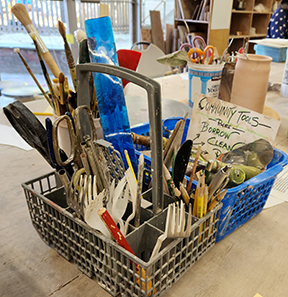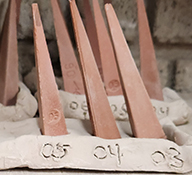How much does clay cost?
The brown stoneware is available free of charge. You can also reclaim clay from any of the recycling barrel for free. There are also 4 additional kinds of clay available for sale in 25 lb. bags:
- White stoneware for $24.00
- Porcelain for $28.00
- Terracotta for $22.00
- Dark Miller 74 Stoneware for $21.00
How much does it cost to fire a piece?
A fee is collected when you submit a piece for its initial bisque firing, based on its weight:
- $2.75 per pound for brown stoneware and other free clay reclaimed from recycling.
- $2.25 per pound for clay you have purchased from CAW.
This fee covers bisque firing, glazing and glaze firing.
Do I have to pay for glazes and glaze firing?
Glazes and glaze firing is included in the fee paid at the time of bisque firing. No additional charges apply to any subsequent process.
Can I pay with Venmo or credit cards?
Currently, the pottery studio accepts only cash and checks as forms of payment.
I still have unglazed pottery after the end of my class. What can I do?
If you are unable to glaze all of your work before your final class and you are not re-registering, you may glaze it during any practice session(s) within the first two weeks of the next term.
I prefer a different clay/glaze from the ones offered by CAW. Can I bring in my own?
In order to prevent contamination, kiln accidents and the like, students are not permitted to use any clay other than the ones offered by CAW. Similarly, only those glazes offered and prepared by the pottery studio can be used.
Are there any tools I can borrow from CAW?

There is a box of common tools on the central table in the pottery studio. They are available for everyone’s use in the studio. Please return them, cleaned, to the box after use.
The pottery studio also offers a basic toolkit for sale. The price is $26.00. Many individual tools are also available for purchase; ask your instructor or a studio potter.
How long does it take for my work to be fired?
We wish there were a definitive answer to this question, but of course, it depends. In the majority of cases, work submitted for bisque firing will be available at your next class. However, extra time may be needed depending on the total volume of work being created in the studio, the availability of kilns (e.g., needed repairs will delay everything), and similar factors.
Many times, stoneware and porcelain pieces are returned from glaze firings after roughly the same interval, but short delays are also not uncommon. Glazes firings for terracotta ware occur much less frequently.
Size matters as the saying goes. In particular, large pieces may not fit into every kiln, and firing rotates between the various kilns, so a piece that fits into, say, just one kiln will typically face a longer wait time until it is returned.
If you have been waiting a long time for a piece to be returned, ask your instructor or a studio potter for clarification of firing schedules and status.
What is a signing symbol?
Potters mark the bottoms of their pots with a signature, initials or other symbol in order to identify the creator of the piece. A signing symbol is a distinctive mark other than a signature or initials that a potter uses for these identificaiton purposes.
Do I have to clean out my shelf between terms if I’m coming back?
With the exception of the August break, you can keep your shelf across terms if you are returning to the same class. You indicate that you are returning by checking the box on the card labeling your shelf and placing a length of masking tape across the front at the end of the term.
Generally, if you are switching to a different class, you will be asked to move to a shelf in the area reserved for that class.
Everyone, without exception, must remove all their things from the pottery studio before the August break each year, regardless of whether they are returning for the fall term.
How do I know if my piece is food safe?
All cone 10 gloss glazes at CAW meet the definition of “food safe” as long as they remain uncrazed. These glossy glazes are chemically stable and contain no lead or other soluble toxic materials. Cone 10 firing applies to brown stoneware, white stoneware and porcelain. Crazing refers to a network of fine cracks on the surface of a pot.
The situation with cone 10 matte glazes and with terracotta pottery is more complex. Consult your instructor for information about the food safety of these materials and processes.
Can I bring my dog to class or practice?
No. CAW does not permit dogs or other pets anywhere within the building. Official service dogs are of course allowed.
How can I find out if CAW is closed for snow or other weather conditions?
Weather closing policies and announcement locations are described here.
How much does clay shrink?
Different clay bodies shrink at different rates, and the manufacturer usually specifies this value. The general range is about 12% to 18%. The brown stoneware provided by CAW shrinks about 14% from wet clay to final cone 10 fired state, but this figure can vary by as much as 2% from batch to batch.
You can estimate the amount your piece will shrink using this formula:
final-size = wet size * (100 – shrinkage-rate)%
For example, a plate that is 12 inches when wet will be about 12 * (100 – 14)% = 12 * (86 / 100) = 10-1/3 inches after glaze firing. (Dividing by 100 converts the percentage to the decimal form needed for the calculation.)
If you want to estimate how large you need to make something to achieve a specific final size, you can use this formula:
wet-size = desired-size / (100 – shrinkage rate)%
Note that 100% minus the shrinkage rate is the percentage remaining after shrinkage: e.g., if clay shrinks 14%, then its final size is 86% of the starting size.
For example, if you want a final fired size of 8 inches, you need to start with a wet piece of 8 / (86 / 100) = 9.3 inches or about 9-1/3 inches.
High fire clay shrinks gradually as it dries and moves through the firing processes, so measuring pieces at different points will give varying results. For example, a piece will be about 95% of the starting size after it is bone dry. It will shrink to somewhere around 92-94% of its initial size after the bisque firing, and then down to about 82-86% of the starting size after glaze firing.
All of this assumes that clay shrinks uniformly, which is not strictly true.
What do the cone numbers mean?

Cones are literally cone-shaped ceramic material that is placed into a kiln to function as a thermometer during the firing process. Cones are manufactured to melt at a very specific and limited range of temperatures. In this way, they provide a visual indication of the temperature inside the kiln. Typically, several cones for consecutive temperature levels are used to ensure that the target range is both reached and not overshot.
Pyrometric cones are numbered in order of increasing temperature range. Numbers start at 022—the initial zero is significant— and then count down to cone 01 with the temperature increasing (e.g., cone 06 is cooler than cone 05). Numbers then continue with 1—without the initial zero—and continue to 14.
The various cone levels are descriptively divided into groups. This is one scheme:
- 022 – 011. Very low fire: 1087°F – 1607°F
- 011 – 02. Low fire: 1657° – 2016°
- 01 – 3. Low-mid fire: 2046° – 2106°
- 4 – 8. Mid fire: 2124° – 2262°
- 8 – 14. High fire: 2280° – 2552° (or higher)
At CAW, kilns are fired to cone 06 for bisque, to cone 05 for terracotta glazing and to cone 10 for high fire glaze firing.